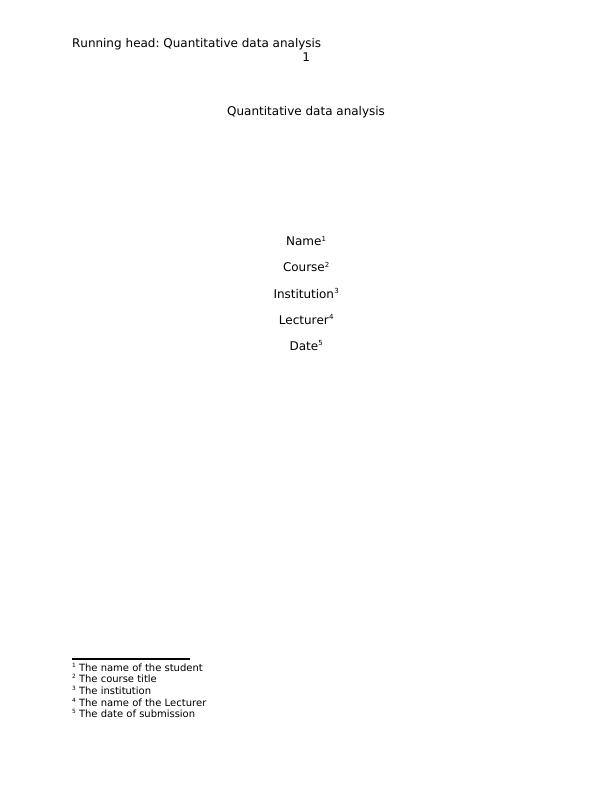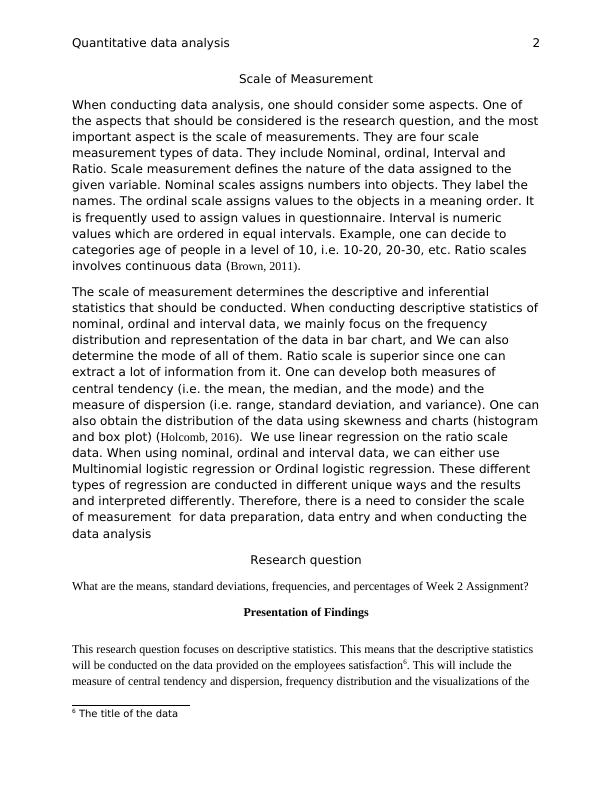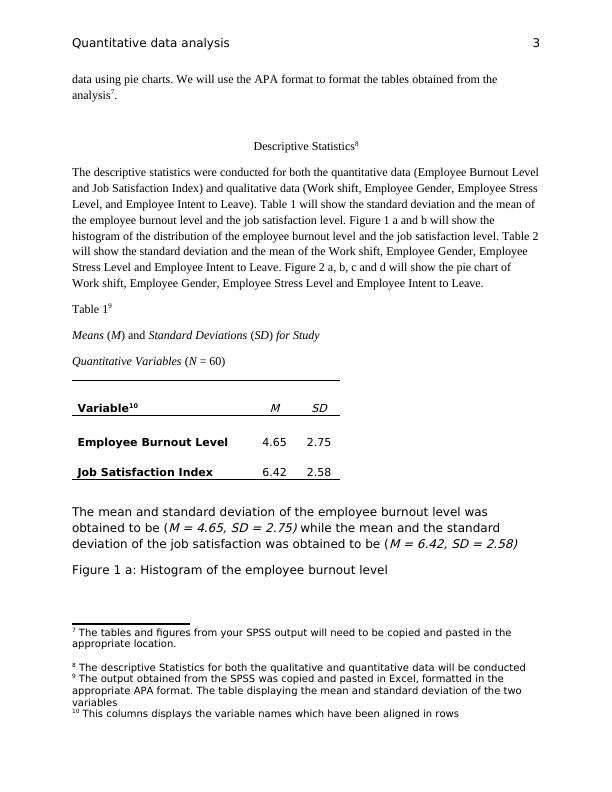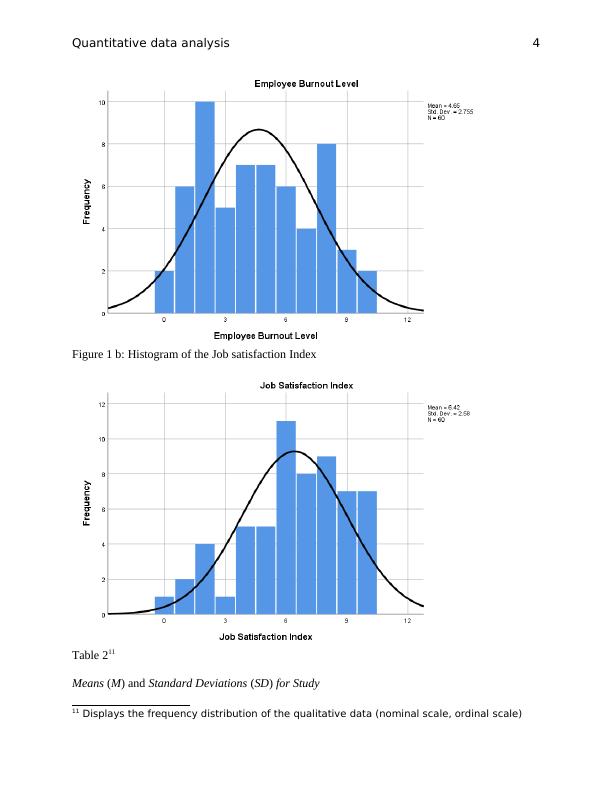Quantitative Data Analysis: Scale of Measurement and Descriptive Statistics
Added on 2022-11-16
14 Pages1209 Words441 Views

Quantitative data analysis 2
Scale of Measurement
When conducting data analysis, one should consider some aspects. One of
the aspects that should be considered is the research question, and the most
important aspect is the scale of measurements. They are four scale
measurement types of data. They include Nominal, ordinal, Interval and
Ratio. Scale measurement defines the nature of the data assigned to the
given variable. Nominal scales assigns numbers into objects. They label the
names. The ordinal scale assigns values to the objects in a meaning order. It
is frequently used to assign values in questionnaire. Interval is numeric
values which are ordered in equal intervals. Example, one can decide to
categories age of people in a level of 10, i.e. 10-20, 20-30, etc. Ratio scales
involves continuous data (Brown, 2011).
The scale of measurement determines the descriptive and inferential
statistics that should be conducted. When conducting descriptive statistics of
nominal, ordinal and interval data, we mainly focus on the frequency
distribution and representation of the data in bar chart, and We can also
determine the mode of all of them. Ratio scale is superior since one can
extract a lot of information from it. One can develop both measures of
central tendency (i.e. the mean, the median, and the mode) and the
measure of dispersion (i.e. range, standard deviation, and variance). One can
also obtain the distribution of the data using skewness and charts (histogram
and box plot) (Holcomb, 2016). We use linear regression on the ratio scale
data. When using nominal, ordinal and interval data, we can either use
Multinomial logistic regression or Ordinal logistic regression. These different
types of regression are conducted in different unique ways and the results
and interpreted differently. Therefore, there is a need to consider the scale
of measurement for data preparation, data entry and when conducting the
data analysis
Research question
What are the means, standard deviations, frequencies, and percentages of Week 2 Assignment?
Presentation of Findings
This research question focuses on descriptive statistics. This means that the descriptive statistics
will be conducted on the data provided on the employees satisfaction6. This will include the
measure of central tendency and dispersion, frequency distribution and the visualizations of the
6 The title of the data
Scale of Measurement
When conducting data analysis, one should consider some aspects. One of
the aspects that should be considered is the research question, and the most
important aspect is the scale of measurements. They are four scale
measurement types of data. They include Nominal, ordinal, Interval and
Ratio. Scale measurement defines the nature of the data assigned to the
given variable. Nominal scales assigns numbers into objects. They label the
names. The ordinal scale assigns values to the objects in a meaning order. It
is frequently used to assign values in questionnaire. Interval is numeric
values which are ordered in equal intervals. Example, one can decide to
categories age of people in a level of 10, i.e. 10-20, 20-30, etc. Ratio scales
involves continuous data (Brown, 2011).
The scale of measurement determines the descriptive and inferential
statistics that should be conducted. When conducting descriptive statistics of
nominal, ordinal and interval data, we mainly focus on the frequency
distribution and representation of the data in bar chart, and We can also
determine the mode of all of them. Ratio scale is superior since one can
extract a lot of information from it. One can develop both measures of
central tendency (i.e. the mean, the median, and the mode) and the
measure of dispersion (i.e. range, standard deviation, and variance). One can
also obtain the distribution of the data using skewness and charts (histogram
and box plot) (Holcomb, 2016). We use linear regression on the ratio scale
data. When using nominal, ordinal and interval data, we can either use
Multinomial logistic regression or Ordinal logistic regression. These different
types of regression are conducted in different unique ways and the results
and interpreted differently. Therefore, there is a need to consider the scale
of measurement for data preparation, data entry and when conducting the
data analysis
Research question
What are the means, standard deviations, frequencies, and percentages of Week 2 Assignment?
Presentation of Findings
This research question focuses on descriptive statistics. This means that the descriptive statistics
will be conducted on the data provided on the employees satisfaction6. This will include the
measure of central tendency and dispersion, frequency distribution and the visualizations of the
6 The title of the data

Quantitative data analysis 3
data using pie charts. We will use the APA format to format the tables obtained from the
analysis7.
Descriptive Statistics8
The descriptive statistics were conducted for both the quantitative data (Employee Burnout Level
and Job Satisfaction Index) and qualitative data (Work shift, Employee Gender, Employee Stress
Level, and Employee Intent to Leave). Table 1 will show the standard deviation and the mean of
the employee burnout level and the job satisfaction level. Figure 1 a and b will show the
histogram of the distribution of the employee burnout level and the job satisfaction level. Table 2
will show the standard deviation and the mean of the Work shift, Employee Gender, Employee
Stress Level and Employee Intent to Leave. Figure 2 a, b, c and d will show the pie chart of
Work shift, Employee Gender, Employee Stress Level and Employee Intent to Leave.
Table 19
Means (M) and Standard Deviations (SD) for Study
Quantitative Variables (N = 60)
Variable10
M SD
Employee Burnout Level 4.65 2.75
Job Satisfaction Index 6.42 2.58
The mean and standard deviation of the employee burnout level was
obtained to be (
M = 4.65, SD = 2.75) while the mean and the standard
deviation of the job satisfaction was obtained to be (
M = 6.42, SD = 2.58)
Figure 1 a: Histogram of the employee burnout level
7 The tables and figures from your SPSS output will need to be copied and pasted in the
appropriate location.
8 The descriptive Statistics for both the qualitative and quantitative data will be conducted
9 The output obtained from the SPSS was copied and pasted in Excel, formatted in the
appropriate APA format. The table displaying the mean and standard deviation of the two
variables
10 This columns displays the variable names which have been aligned in rows
data using pie charts. We will use the APA format to format the tables obtained from the
analysis7.
Descriptive Statistics8
The descriptive statistics were conducted for both the quantitative data (Employee Burnout Level
and Job Satisfaction Index) and qualitative data (Work shift, Employee Gender, Employee Stress
Level, and Employee Intent to Leave). Table 1 will show the standard deviation and the mean of
the employee burnout level and the job satisfaction level. Figure 1 a and b will show the
histogram of the distribution of the employee burnout level and the job satisfaction level. Table 2
will show the standard deviation and the mean of the Work shift, Employee Gender, Employee
Stress Level and Employee Intent to Leave. Figure 2 a, b, c and d will show the pie chart of
Work shift, Employee Gender, Employee Stress Level and Employee Intent to Leave.
Table 19
Means (M) and Standard Deviations (SD) for Study
Quantitative Variables (N = 60)
Variable10
M SD
Employee Burnout Level 4.65 2.75
Job Satisfaction Index 6.42 2.58
The mean and standard deviation of the employee burnout level was
obtained to be (
M = 4.65, SD = 2.75) while the mean and the standard
deviation of the job satisfaction was obtained to be (
M = 6.42, SD = 2.58)
Figure 1 a: Histogram of the employee burnout level
7 The tables and figures from your SPSS output will need to be copied and pasted in the
appropriate location.
8 The descriptive Statistics for both the qualitative and quantitative data will be conducted
9 The output obtained from the SPSS was copied and pasted in Excel, formatted in the
appropriate APA format. The table displaying the mean and standard deviation of the two
variables
10 This columns displays the variable names which have been aligned in rows

End of preview
Want to access all the pages? Upload your documents or become a member.
Related Documents
Quantitative Research Methods for Social Scientistslg...
|8
|1823
|225
Quantitative Research Methods for Social Scientists Written Paperlg...
|8
|1412
|101
Basic Business Statistics Hardcoverlg...
|11
|1569
|17
Quantitative Research Methods for Social Scientistslg...
|8
|1258
|494
Data Analytic and Business Intelligence Reports 2022lg...
|6
|1586
|17
Business Statistics Report 2022lg...
|18
|1751
|22
